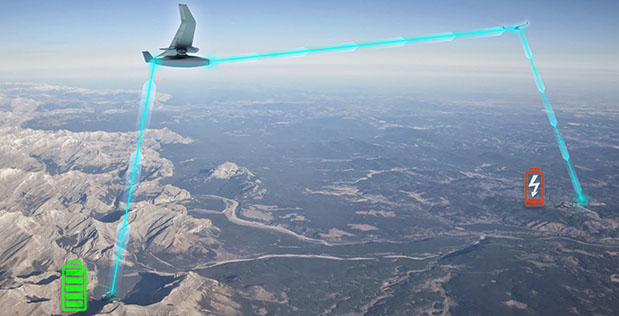Lasers Instead of Batteries? Startup Beams Power to Drones Mid-Flight

NextGen Defense spotlights the startups redefining military tech, cutting through the hype to examine the innovations driving the future of defense.
Tom Nugent‘s company is developing what sounds like science fiction but is reality: beaming power through the air using high-powered lasers to keep drones flying indefinitely.
The CTO of PowerLight Technologies believes their wireless power transmission and distribution system could fundamentally change how uncrewed systems operate in defense and commercial applications.
The concept emerged from observations about improving laser technology. Nugent noted that his late co-founder, Dr. Jordin Kare, identified early innovations showing “a steady Moore’s law-like improvement in lasers” where “the power and the efficiency kept increasing, and most importantly, the cost per watt of optical output would fall in half every three years.”
“We could see a future where lasers would become so cheap that it would make economic sense to deliver energy this way,” Nugent explained.
How Laser Power Transmission Works
PowerLight’s system uses high-power lasers to transmit energy to specialized photovoltaic cells called laser power converters, which convert laser light into electricity.
Nugent described the technology as creating “end-to-end systems” that can connect power sources, whether solar panels or the electric grid, to locations where traditional power infrastructure cannot easily reach.
“A prime example for the defense industry is drones that fly and have a limited amount of time they can spend in the air or on their mission because of the limits of battery and how dilute sunlight is,” Nugent added.
The company focuses heavily on making the receiver side “as efficient, lightweight, and robust as possible” while emphasizing safety technology to ensure the system operates “as safe as a regular extension cord,” according to Nugent.
Safety Measures and Electronic Warfare Resistance
Given the use of high-power lasers, safety represents a critical concern.
Nugent explained that PowerLight employs “a multilayer safety system that detects any objects that approach the high-intensity laser beam” and then “temporarily deactivates the laser so that nothing can get exposed to the high-intensity light.”
When objects pass out of interference range, the laser reactivates, while receiving devices continue operating on onboard batteries during brief interruptions.
Nugent noted that third-party organizations, including the Department of Defense’s Navy Laser Safety Review Board, have tested these safety measures.
Regarding electronic warfare vulnerabilities, Nugent argued that the technology shows inherent resistance to jamming.
“The technology itself is not susceptible to electronic warfare, except in cases where the electronics inside the system are directly affected. For example, a very strong electromagnetic pulse could impact electronic components,” he said.
“But the light itself, imagine it like a flashlight or a visible laser beam or laser pointer, is difficult to disrupt,” he added, though he acknowledged limitations including line-of-sight requirements and inability to penetrate clouds or hills.
However, he noted there are “ways to route the beam to go around things, like going over a hill and relay the beam back down.”
Government Partnerships and Combat Readiness
The Department of Defense has emerged as “an extremely important partner in buying down the risk on the new technology,” according to Nugent.
He highlighted support from CENTCOM and other agencies, including the Operational Energy Innovation Organization under the Office of the Secretary of Defense, along with partnerships with Lockheed Martin.
“People across CENTCOM and other agencies see all the different ways the technology can be applied. They have specific interests in drones, and they have been supportive in helping us mature this technology and get it to field trials needed to advance it to full deployment,” Nugent stated.
However, the technology remains in prototype stages and has not been deployed in combat zones.
Market Competition and Applications
While acknowledging competition in wireless power transmission, Nugent distinguished PowerLight’s approach.
“There are a number of companies working in the wireless power industry, and they have different differentiators,” he said. Many competitors focus on “low power, short distance applications, like IoT devices; things that are sending the power across the room” using lasers or microwaves.
At higher power and longer distances, “fewer groups are working on it,” he noted.
Among competitors working at “kilowatts at kilometers scale of power and distance,” some focus on microwave power beaming while others work on individual components — transmitters or receivers — “whereas we do everything end-to-end,” Nugent said.
He also mentioned “a couple of startups looking to do power beaming from orbit down to the ground” with “very large transmitters,” though those remain “still relatively early in their development.”
Beyond defense applications, Nugent sees significant commercial potential, particularly in telecommunications.
“While the communications devices might be different, the employment would be potentially similar,” he stated when comparing military ISR and communications missions to telecom industry needs.





